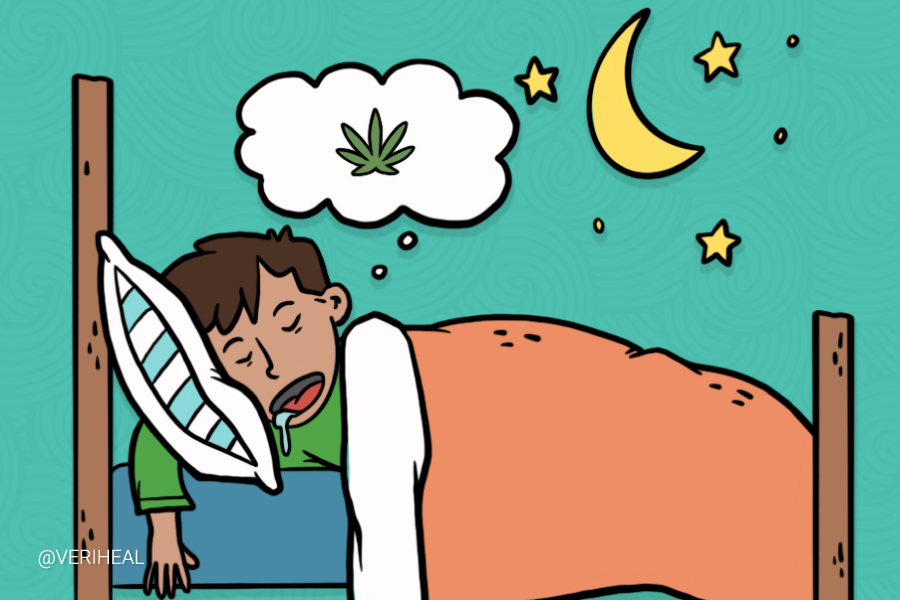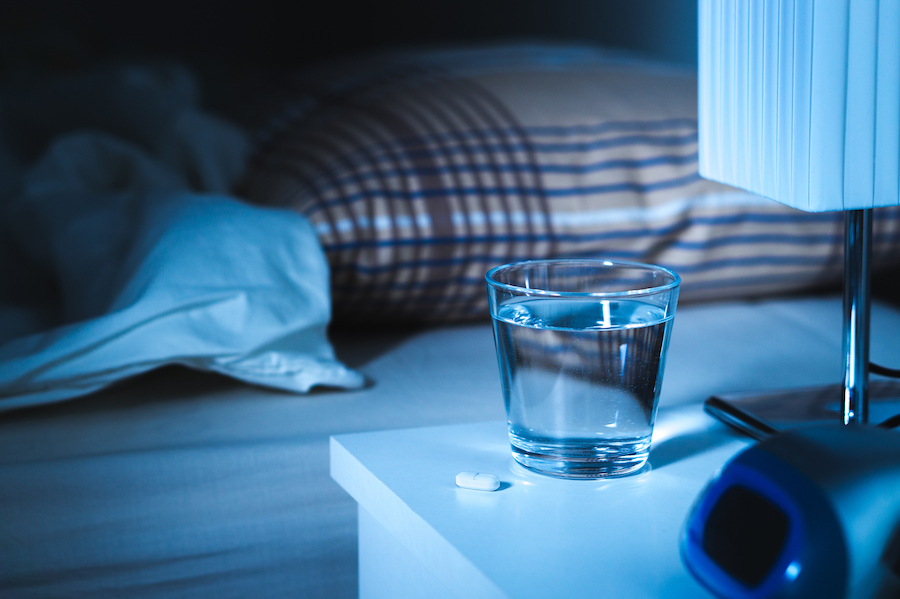How Medical Marijuana is Helping Insomnia Patients Sleep

What You Need To Know: Cannabis and Insomnia
Can cannabis help you sleep? Early research shows promising potential.
Insomnia can result from various factors, including medical conditions, medications, stress, and environmental factors.
When we consume cannabis, compounds in the plant interact with our endocannabinoid system, a bodily system that influences biological functions—including anxiety, perception of pain, and sleep regulation. Specifically, the primary cannabinoids THC and CBD offer relaxation and calming effects, potentially alleviating insomnia symptoms.
Additionally, other cannabis compounds called terpenes offer anti-inflammatory and pain-relieving properties that could aid in insomnia relief. In particular, the terpenes myrcene, caryophyllene, limonene, and linalool may relieve stress and promote relaxation and sedation.
Indica strains, in particular, are often rich in these compounds. As a result, Indica cannabis strains have a reputation for their sedative, relaxing, and pain-relieving properties, all elements that could help promote healthier sleep.
Always consult with your doctor before making a change to your medical cannabis routine, especially when combining it with other sleep aids or medications.
The Science Behind Medical Cannabis for Insomnia:
- Should you Try CBD for Insomnia
- Terpenes to Improve Sleep
- Using Medical Marijuana for Insomnia
- Insomnia and Medical Cannabis: Considerations to Keep in Mind
- Causes of Insomnia
- What are the Stages of Sleep?
One reason why cannabis helps people with falling asleep and staying asleep is through its role activating the endocannabinoid system. Endocannabinoids are naturally made in your body and are fat-based neurotransmitters that control various functions in your body.
Scientists have identified almost 150 different compounds called cannabinoids that work to activate CB1 and CB2 receptors in the body (13). CB1 receptors are mostly located in the central nervous system, while CB2 receptors are in other parts of the body such as in your joints and digestive system.
The most well-known cannabinoids are Δ9-tetrahydrocannabinol (THC) and cannabidiol (CBD). These chemicals have been studied the most. When medical cannabis is consumed, anandamide (AEA) and Arachidonoyl glycerol (2-AG) endocannabinoids are activated. These endocannabinoids help regulate the body’s circadian rhythm and are directly influenced by cannabis consumption, helping regulate sleep (5).
Scientists believe that when 2-AG is released into the lateral hypothalamus portion of the brain, it stimulates the activity of sleep-promoting melanin-concentrating neurons (MHC), and increases rapid eye-movement sleep (REM) (5). However, this is interestingly contradicted by the fact that increasing endocannabinoid tone with enzymes, rather than by a direct injection, actually decreased REM sleep. The REM stage of sleep is associated with dreaming. This is particularly useful for patients who have difficulty sleeping because of nightmares.
Check out our guide on endocannabinoids to learn more about how medical marijuana works in your body.
Should you Try CBD for Insomnia?
A variety of studies have been done on the use of CBD and whether it helps people with insomnia. Most of these studies show that it does not give patients any significant improvements in their sleep (5). Keeping that in mind, if you suffer from insomnia due to chronic pain or other chronic conditions, CBD may help relieve the symptoms of the conditions and in turn, help improve your sleep.
What is Cannabinol?
Cannabinol (CBN) is a cannabinoid that enters the body when THC is being metabolized (17). It can be found in all cannabis flowers in small amounts and is a strong sedative that can be compared to prescriptions like Valium or Xanax. More research is needed on CBN, but products that contain CBN can be purchased at dispensaries to help with insomnia and other sleep issues.
Terpenes to Improve Sleep
Terpenes are chemicals that can be found in many plants, including marijuana, and are responsible for scents and secondary effects such as being anti-bacterial, improves memory etc. Please check out our page discussing common terpenes for more information.
Cannabis terpenes that help with sleep are (16):
- Myrcene
- Smells like cloves
- Relieves inflammation, pain, and insomnia
- Caryophyllene
- Limonene
- Citrus smell
- Stress reducer, anti-depressant, and anxiety reducer
- Linalool
- Spicy, lavender smell
- Relieves anxiety, stress, inflammation, insomnia, and pain
Using Medical Marijuana for Insomnia
When using medical cannabis for treating insomnia, it is a good idea to track your sleep quality and the doses you used in a log. In addition, taking medical marijuana orally via tinctures or capsules is a good method because the doses are easier to measure and track. If you are new to medical cannabis, it is recommended to start with smaller doses at first until you know how it makes your body feel.
While many patients prefer to smoke or inhale cannabis, the drawbacks include difficulty measuring doses as well as the potential for lung-related health issues. Much like tobacco, smoking flower can irritate the bronchial air passages in the lungs (14).
When purchasing cannabis for sleep problems, make sure to look for strains that are higher in THC vs. CBD because some studies show that low doses of CBD makes patients more alert. Also, many patients like taking Indica strains for the treatment of insomnia, though the differences between Indica and Sativa are not as clear-cut as once thought.
Insomnia and Medical Cannabis: Considerations to Keep in Mind
Repeated use of cannabis leads to a higher tolerance, and higher doses are needed to achieve the same results over time. This is also true for using medical cannabis to improve the quality of sleep you get as well as for help falling asleep (5).
Heavy cannabis users often experience poor sleep quality when they stop taking cannabis. In fact, this is a major reason why users resume cannabis after quitting (5).
It is important to talk with your doctor about using medical marijuana for insomnia, especially if you are already taking other sleep aids because they may interact with each other and have other negative side effects.
Causes of Insomnia
Insomnia is defined by a person having trouble falling asleep or difficulty staying asleep. It can be idiopathic, which means there is no known cause. It can also be caused by the following (1):
- Medical Conditions
- Chronic obstructive pulmonary disease (COPD)
- Gastroesophageal reflux disease (GERD)
- Stress
- Anxiety
- Depression
- Restless leg Syndrome (RLS) and other sleep disorders
- Post-traumatic stress disorder (PTSD)
- Allergies
- Parkinson’s disease
- Chronic pain
- Medications
- SSRI antidepressants
- ACE inhibitors and beta blockers
- Allergy medications
- Blood pressure medications Asthma medications
- Disruption in circadian rhythm
- This is the body’s natural sleep and wake rhythm.
- Can be disrupted by poor sleeping habits (or “sleep hygiene”) (12)
- Environment
- The room is too hot, too cold, too loud, too bright, etc.
What are the Stages of Sleep?
The five stages of sleep include (2):
- Stage 1 sleep
- Lightest stage of sleep
- Brain electroencephalogram (EEG) readings are slightly lower then they are while awake
- Breathing occurs at normal rate
- Muscle tone is still present
- Stage 2 sleep
- Deeper sleep then stage 1
- Sleeper less able to be awakened
- Sleep Stages 3 & 4
- Progressive levels of deep sleep
- EEG readings are slower frequency but higher amplitude
- If a person is awoken during stage 3 sleep, they will be quite groggy and experience impaired mental performance for up to 30 minutes. This is called sleep inertia
- Stage 5 Sleep
- Considered rapid eye movement sleep (REM)
- EEG readings are like those who are awake
- Muscles are without movement. Scientists think this is to protect the individual from injury during sleep
- Breathing is erratic and irregular and heart rate is increased
- This sleep cycle is associated with dreaming, but dreaming can occur in the other non-REM stages of sleep
Note: Veriheal does not intend to give this as professional medical advice. Do not attempt to self-diagnose, or prescribe treatment based on the information provided on this page. Always consult a physician before making any decision on the treatment of a medical condition.
1. ASA Authors & Reviewers. (n.d.). Insomnia causes. Retrieved February 04, 2021, from https://www.sleepassociation.org/sleep-disorders/insomnia/insomnia-causes/
2. ASA Authors & Reviewers. (n.d.). Stages of sleep: The sleep cycle. Retrieved February 04, 2021, from https://www.sleepassociation.org/about-sleep/stages-of-sleep/
3. Babson, K. A., Sottile, J., & Morabito, D. (2017). Cannabis, Cannabinoids, and Sleep: a Review of the Literature. Current psychiatry reports, 19(4), 23. https://link.springer.com/article/10.1007%2Fs11920-017-0775-9
4. Belendiuk, K. A., Babson, K. A., Vandrey, R., & Bonn-Miller, M. O. (2015). Cannabis species and cannabinoid concentration preference among sleep-disturbed medicinal cannabis users. Addictive behaviors, 50, 178–181. https://www.sciencedirect.com/science/article/abs/pii/S0306460315002269?via%3Dihub
5. Kesner, A. J., & Lovinger, D. M. (2020). Cannabinoids, Endocannabinoids and Sleep. Frontiers in molecular neuroscience, 13, 125. https://www.frontiersin.org/articles/10.3389/fnmol.2020.00125/full
6. Kuhathasan, N., Dufort, A., MacKillop, J., Gottschalk, R., Minuzzi, L., & Frey, B. N. (2019). The use of cannabinoids for sleep: A critical review on clinical trials. Experimental and clinical psychopharmacology, 27(4), 383–401. https://doi.apa.org/doiLanding?doi=10.1037%2Fpha0000285
7. National Center for Biotechnology Information (2021). PubChem Compound Summary for CID 2543, Cannabinol. Retrieved February 4, 2021 from https://pubchem.ncbi.nlm.nih.gov/compound/Cannabinol
8. Shannon, S., Lewis, N., Lee, H., & Hughes, S. (2019). Cannabidiol in Anxiety and Sleep: A Large Case Series. The Permanente journal, 23, 18–041. http://www.thepermanentejournal.org/issues/43-the-permanente-journal/original-research-and-contributions/6960-cannabidiol-in-anxiety-and-sleep-a-large-case-series.html
9. Suraev, A., Grunstein, R. R., Marshall, N. S., D’Rozario, A. L., Gordon, C. J., Bartlett, D. J., Wong, K., Yee, B. J., Vandrey, R., Irwin, C., Arnold, J. C., McGregor, I. S., & Hoyos, C. M. (2020). Cannabidiol (CBD) and Δ9-tetrahydrocannabinol (THC) for chronic insomnia disorder (‘CANSLEEP’ trial): protocol for a randomised, placebo-controlled, double-blinded, proof-of-concept trial. BMJ open, 10(5), e034421. https://bmjopen.bmj.com/content/10/5/e034421
10. Vigil, J. M., Stith, S. S., Diviant, J. P., Brockelman, F., Keeling, K., & Hall, B. (2018). Effectiveness of Raw, Natural Medical Cannabis Flower for Treating Insomnia under Naturalistic Conditions. Medicines (Basel, Switzerland), 5(3), 75.https://www.mdpi.com/2305-6320/5/3/75
11. Winiger, E. A., Hitchcock, L. N., Bryan, A. D., & Cinnamon Bidwell, L. (2021). Cannabis use and sleep: Expectations, outcomes, and the role of age. Addictive behaviors, 112, 106642. https://www.sciencedirect.com/science/article/abs/pii/S0306460320307723?via%3Dihub
12. Centers for Disease Control and Prevention. (2016, July 15). CDC – Sleep Hygiene Tips – Sleep and Sleep Disorders. Centers for Disease Control and Prevention. https://www.cdc.gov/sleep/about_sleep/sleep_hygiene.html
13. Citti, C., Linciano, P., Russo, F., Luongo, L., Iannotta, M., Maione, S., Laganà, A., Capriotti, A. L., Forni, F., Vandelli, M. A., Gigli, G., & Cannazza, G. (2019). A novel phytocannabinoid isolated from Cannabis sativa L. with an in vivo cannabimimetic activity higher than Δ9-tetrahydrocannabinol: Δ9-Tetrahydrocannabiphorol. Scientific Reports, 9(1). https://www.nature.com/articles/s41598-019-56785-1
14. Fugh-Berman, A., Wood, S., Kogan, M., Abrams, D., Mathre, M. L., Robie, A., Raveendran, J., Onumah, K., Mehta, R. S., White, S., Kasimu-Graham, J., & D’Antonio, P. (n.d.). An Introduction to the Biochemistry & Pharmacology of Medical Cannabis. Washington D.C.; Government of the District of Columbia DOH. https://doh.dc.gov/sites/default/files/dc/sites/doh/publication/attachments/Medical%20Cannabis%20An%20Introduction%20to%20the%20Biochemistry%20and%20Pharmacology.pdf
15. Hwang, E.-S., Kim, H.-B., Lee, S., Kim, M.-J., Kim, K.-J., Han, G., Han, S.-Y., Lee, E.-A., Yoon, J.-H., Kim, D.-O., Maeng, S., & Park, J.-H. (2020). Antidepressant-like effects of β-caryophyllene on restraint plus stress-induced depression. Behavioural Brain Research, 380, 112439. https://www.sciencedirect.com/science/article/abs/pii/S0166432819313348?via%3Dihub
16. Russo E. B. (2011). Taming THC: potential cannabis synergy and phytocannabinoid-terpenoid entourage effects. British journal of pharmacology, 163(7), 1344–1364. https://www.ncbi.nlm.nih.gov/pmc/articles/PMC3165946/
17. U.S. National Library of Medicine. (n.d.). Cannabinol. National Center for Biotechnology Information. PubChem Compound Database. https://pubchem.ncbi.nlm.nih.gov/compound/Cannabinol









